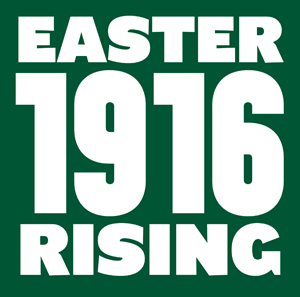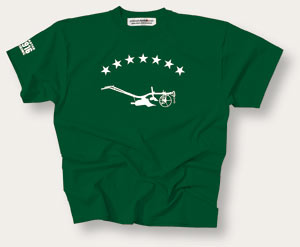
Ireland Always Rising
14.03.16
For St Patrick’s Day Mark Perryman outlines the meaning of the forthcoming Easter Rising Centenary for models of Britishness
 St Patrick’s Day. Down the local, one of the best night outs of the year, a non-stop party drenched in all things Irish. A celebration of Ireland’s freedom, which can never be entirely separated from history either.
St Patrick’s Day. Down the local, one of the best night outs of the year, a non-stop party drenched in all things Irish. A celebration of Ireland’s freedom, which can never be entirely separated from history either.
For decades it was Ireland that defined first the British Right, the Conservative and Unionist party remember, and then latterly the street-fighting Far Right too with their links loyalist paramilitaries and hatred of all things otherwise from Ireland. Today such connections are broken, the last remnants the unofficial insertion of ‘No Surrender’ into the National Anthem (sic) by a section of the football crowd at England internationals. No surrender? To what exactly.
But the framing of Britishness via its relationship to Ireland has to be accounted for by a range of factors beyond the narrowly political. St Patrick’s Day is emblematic of the complexity and contradictions. Britishness is far more accommodating and porous than it is often credited for. Beyond the body politic take music, popular literature, film and sport where a particular version of Irishness has been embraced. From punk icons Stiff Little Fingers to the Pogues, Sinead O’Connor and The Corrs via Hothouse Flowers and Sawdoctors to the mega-success of U2 this is a cultural insurgency that cannot be lightly discounted. Not so long ago North London’s Finsbury Park would be packed out for the two-day Fleadh festival with an extraordinary range of artists parading their Irish heritage. Glasgow’s Celtic Connections celebration today does something similar.
Roddy Doyle, particularly with his Barrytown trilogy of novels transformed for a generation what Irish identity might look like. Full of humour yet never losing sight of where they’d come from and what Ireland had been though to get there. In his recent work a more obviously political author Doyle has never though once lost his popular edge.
This summer, in the year of the 1916 Easter Rising Centenary, Northern Ireland and the Republic will both compete, together and independently of one another, in a major football tournament for the first time. At Euro 2016 there will be two ‘Green and White Armies.’ There’s some history here, not apart from the politics but affected by it, and shaping the political in return too. Northern Ireland made it to World Cup ’82 in Spain, with Martin O’Neill a star of the team who now manages the Republic. They were there in Mexico four years later too for World Cup’86. Then the Republic kind of took over, Euro ’88, Italia 90, World Cup ’94 , managed by Englishman Jack Charlton, one of the heroes of the England ’66 World Cup-winning team. Big Jack built an Irish team around finding players in the English and Scottish leagues who qualified for Ireland via parentage but previously had never thought of playing for the Republic. But notwithstanding the bending of who can and can’t ‘represent’ Ireland something more important was perhaps underway. As the troubles in Northern Ireland edged their way towards an unfolding peace process on the pitch and in the stands what it meant to be Irish and what Ireland might become was being transformed.
But there remain those who would prefer to rewrite their own history. Jeremy Corbyn and John McDonnell were on Labour’s back benches when the IRA’s military campaign was in full and lethal swing. They were amongst the few who at the time argued that what was needed was a political solution and this must include both a dialogue with those behind the bombing and the ending of injustices dished out.They were demonised as ‘terrorist sympathisers’ then. A Tory Party that seems to have forgotten John Major’s role in initiating the peace process is clearly gearing up to use those self-same smears now against a Labour Leader and his Shadow Chancellor some thirty years later.
In Irish politics meanwhile we have seen the emergence of the civic nationalism of Sinn Fein, first mostly in the North but increasingly in the South too, of course it goes without saying that Sinn Fein like all those committed to a United Ireland recognise no such border. An anti-austerity party that sits in the European Parliament with the European United Left alongside socialist and communist parties is a very different proposition to what might have been imagined was possible at the height of the Provos campaign in the 1980s. And in the 2016 Irish General Election alongside the election of Sinn Fein TDs anti-austerity TDs were also elected, while the Irish Labour Party continued its woeful decline, or Pasokification. Sinn Fein and the Anti-Austerity Alliance/People Before Profit alliance are not the same but what they do have in common is a militancy they claim as a shared inheritance from Easter 1916.
A centenary is an excuse, of course, for looking back and that search for meaning is always contested, or at least it should be. We should be able to account for the cultural shifts in how Irish national identity is shaped, the politics of Sinn Fein and others’ civic nationalism understood while the factors that created the conditions for a political solution in place of a military strategy perhaps in these troubled times demand the most careful revisiting of all.
This year’s St Patrick’s Day for many will be the prelude to the Easter Rising Centenary celebrations just a week and a bit later. The connections between the popular culture of a night out and a political legacy will never have been more obvious. Dublin today is a serious competitor to Barcelona and Prague as amongst budget airline travellers’ favourite European destinations for a city break, another instance of the connections between the cultural and the political. Many will visit O’Connell Street to take a snap of the iconic Dublin General Post Office. But of course this isn’t simply a splendid example of late Georgian architecture nor merely a handy place to post a postcard home. It was the HQ in 1916 for the men and women who fought in the Easter Rising. This is a rebel city, a rebel culture, a rebel country that was to break the Union. Ahead of the rising across the front of Dublin’s Liberty Hall, home of the Irish Transport and General Workers Union, a banner was hung ‘We serve neither King nor Kaiser but Ireland.’ This was the nature of that break, the cause of self-determination and independence. Yet as Fintan O’Toole has pointed out some quarter of a million Irishmen fought in the First World war on the British side and during the course of the Rising 570 Irish soldiers lost their lives on the Western Front following a particularly lethal German gas attack. So that breakage is complicated, it was partial and while some defined their nationalism as ‘my enemy’s enemy is my friend’ whatever their motives and intentions, others didn’t. And Irish Nationalism had its internationalist side too, the Irish volunteers who fought with the International Brigades in the Spanish Civil War famously called themselves The Connolly Column, their Irishness fusing with the cause of land and freedom. While others defined the cause of Ireland in terms of the purity of a particular version of Catholicism to side with Franco against the Spanish republic.
Today a faith-based politics is of decreasing importance in the modern Ireland as evidenced by the referendum vote in favour of equality in marriage for Lesbians and Gay men. It was James Connolly’s vision that ‘the Irish people will not be free until they own everything from the plough to the stars.’ It is this vision that more than anything should frame how we celebrate Easter 1916. As a very Irish moment when the human potential of freedom and equality was most evident and could never be extinguished whatever the scale and might of the forces ranged against it. To that all of us, Irish or not, should gladly raise a glass on Thursday night. Happy St Patrick’s Day!
 Philosophy Football’s Easter 1916 T-shirt range, 20% off until St Patrick’s Day quote coupon code Easter 2016 at checkout. The T- shirts are available from here
Philosophy Football’s Easter 1916 T-shirt range, 20% off until St Patrick’s Day quote coupon code Easter 2016 at checkout. The T- shirts are available from here